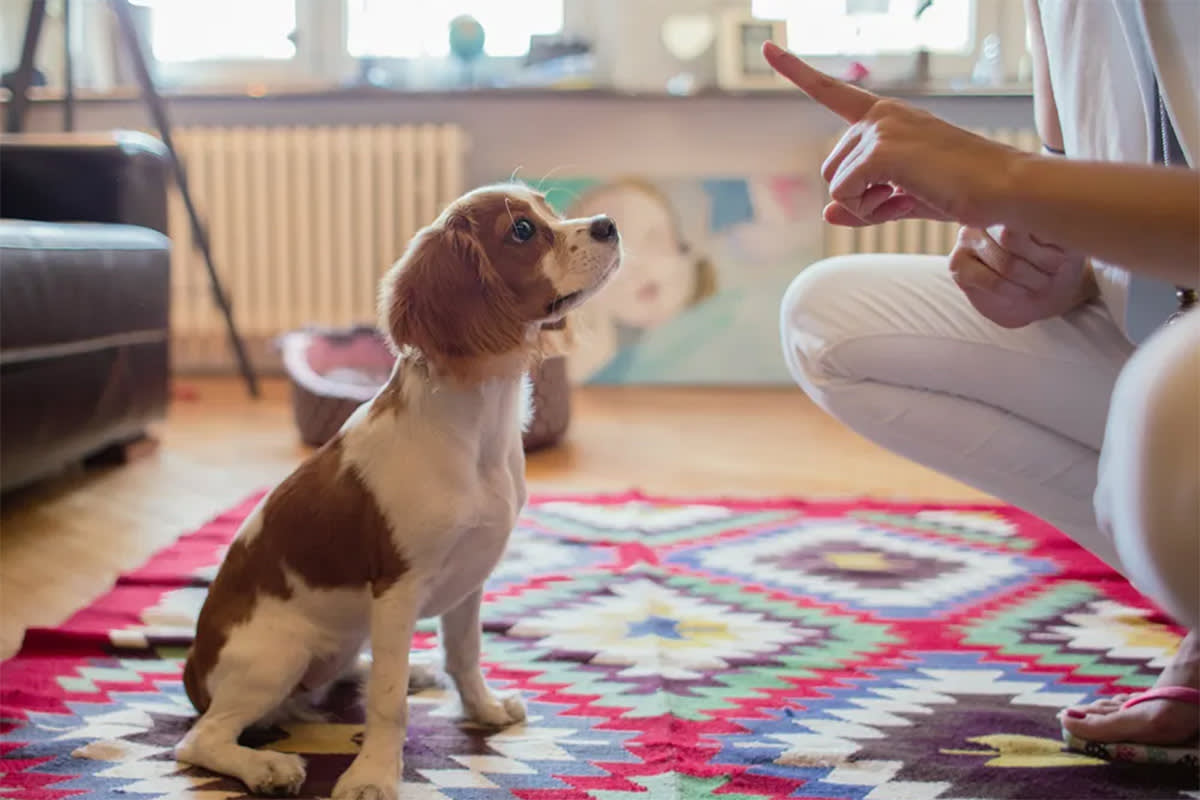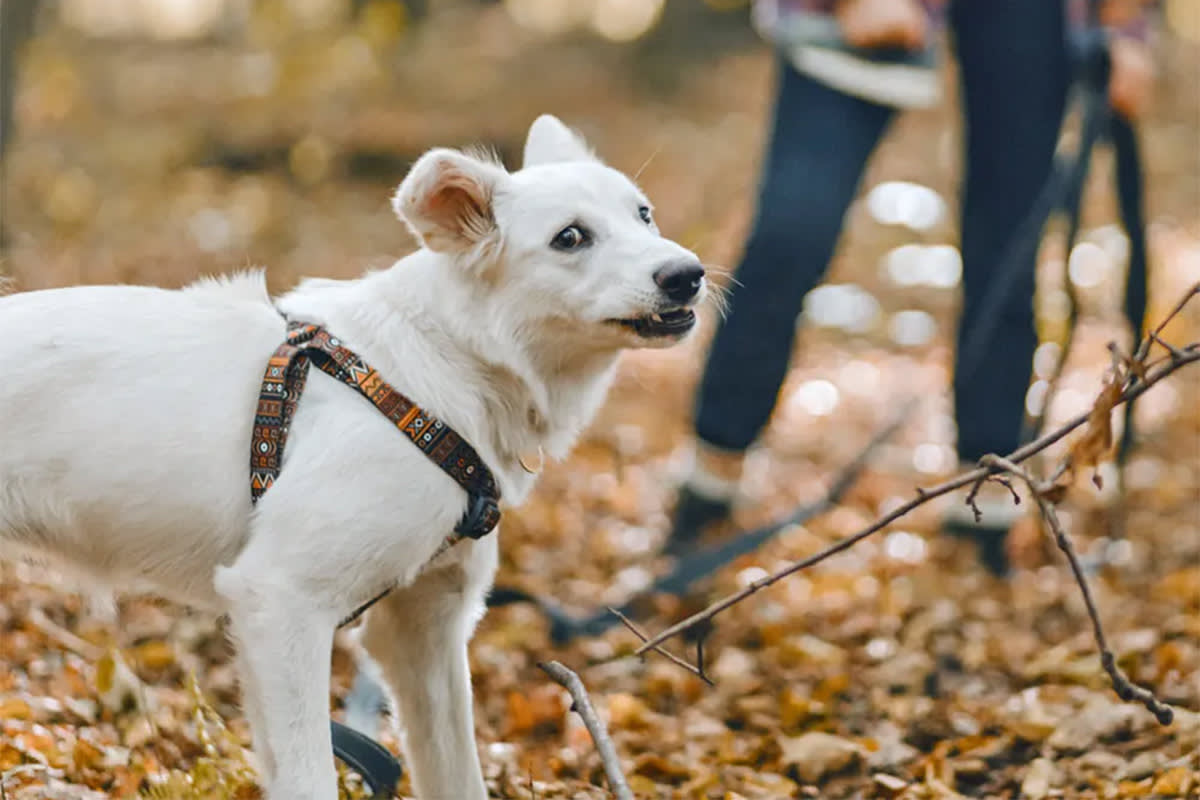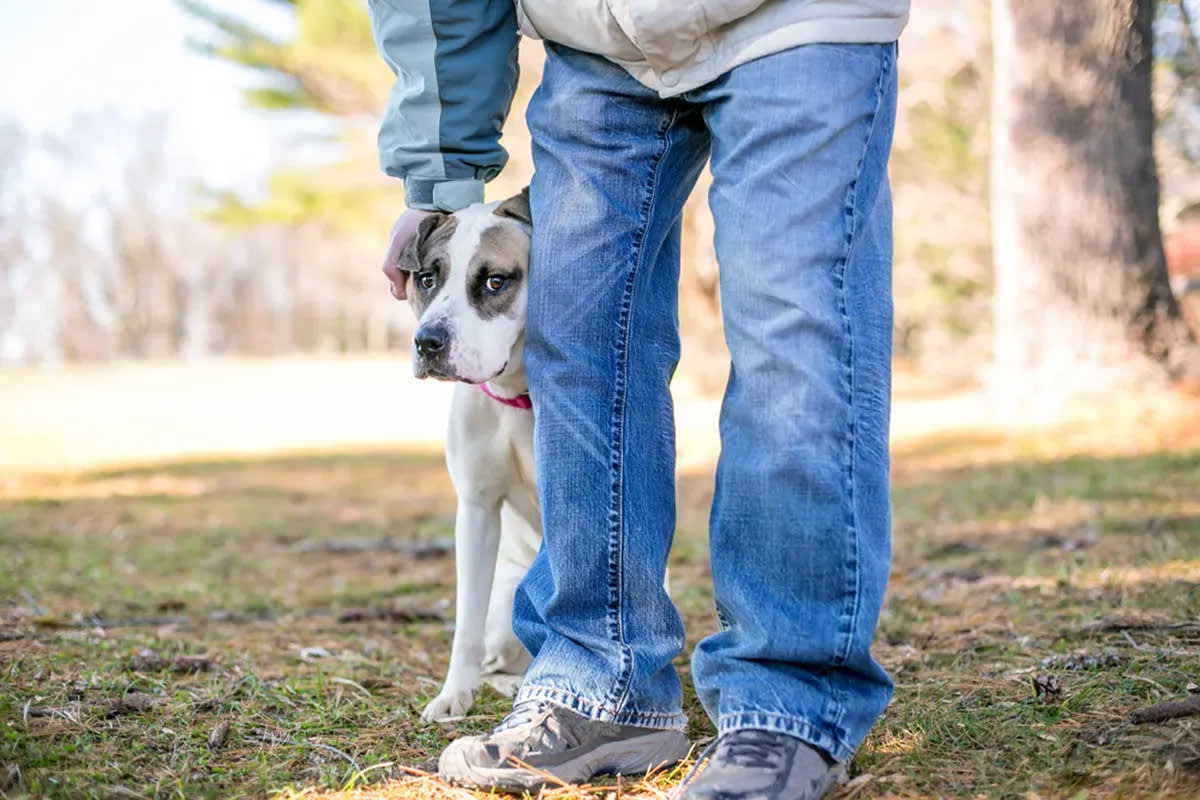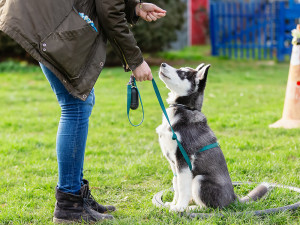9 Red Flags to Watch Out For in Social Media Dog Trainers
Don’t let slick editing and the promise of a quick fix fool you.
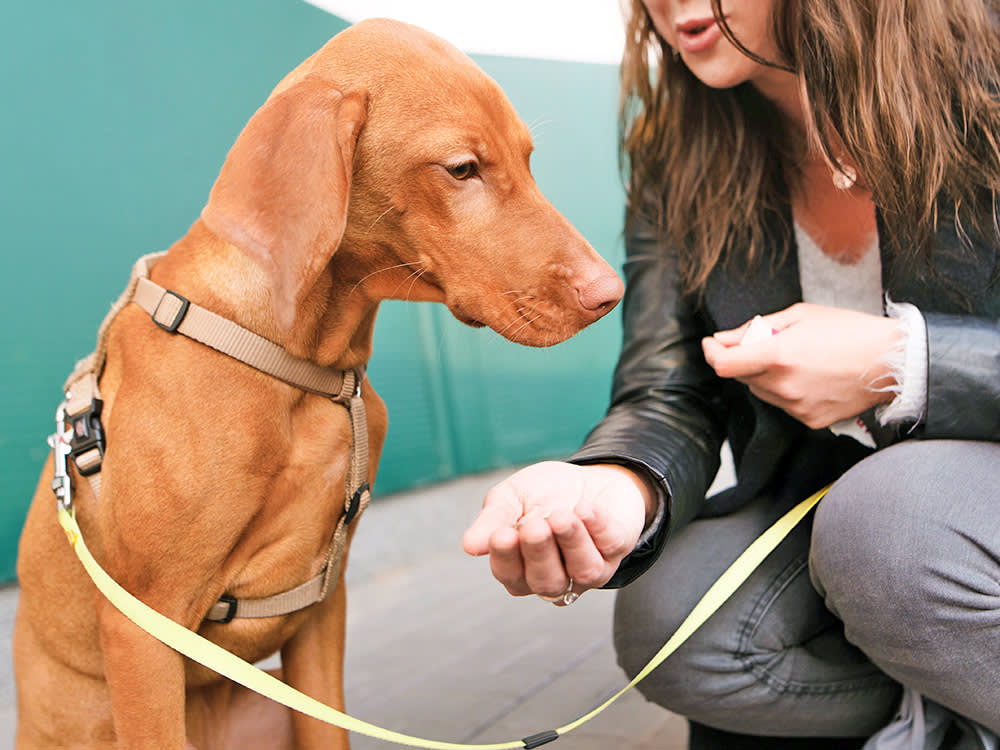
Share Article
Dog training is hard. It takes time, skill, and dedication. You have to know what you are doing, do it consistently, and be patient — both with your dog and with yourself. It can be boring and frustrating, and it requires constant reinforcement. It’s exhausting and monotonous, and even if you hire a professional trainer, you still have to do most of the work yourself. At home. On the daily. Just you and your dog.
And a lot of people don’t want to do that, at least not consistently. “Most of my clients never do their homework,” says one NYC trainer who prefers to remain anonymous. “The only training their dog gets is when I’m there.” The trainer adds that though the client doesn’t do any work in between sessions, they still act frustrated when the dog isn’t making progress.
Next, the trainer says, the inevitable happens: “Then they either ghost me or say I’m not doing a good enough job and fire me... People say they want to train their dogs, but what many of them really want is to be entertained and for their dogs to ask less of them.” When this happens, people turn to social media, where they can find short, easy videos (and online trainers can’t scold them for not doing the work at home).
Is social-media training a good idea?
Social-media dog training is first and foremost a form of entertainment. Can you learn stuff from it? Sure. But the algorithm prioritizes videos that perform well, not videos that give accurate, helpful information. And the videos that perform well are the ones that are short, easy to understand, have trendy music and slick editing, and eschew nuance. Can you find good dog trainers on social media? Of course you can. But most of the trainers you are likely to find — whether you search for their videos yourself or they are placed directly into your feed by the algorithm — are going to be entertainers and content creators first and dog trainers second.
How much do you spend on your pet per year?

For this reason, if you are going to look to social media for dog-training advice, it’s essential that you learn to distinguish good advice from bad. And good trainers from bad. Again, social media does not reward truth or utility; it rewards your ability to engage and entertain. And dog training — real dog training — is most often not entertaining.
If you watch a bad dog trainer online because they are entertaining, over time, you will absorb the things they are saying. If and when it comes time for you to take some sort of action to alter your dog’s behavior, your approach will be influenced by what you have seen and heard in those videos. So, be careful.
And if you are turning to social media for dog-training tips, be on the lookout for these nine red flags. If and when you see one of these things, stop watching, unfollow, or — at the very least — take what that trainer is saying with the tiniest grain of salt.
They use aversive tools like shock or prong collars.
“These tools suppress behavior without addressing the root cause,” says Qiai Chong, chief animal behaviorist and co-founder of Pet Coach Singaporeopens in new tab. “For instance, a dog may stop barking due to discomfort, but if the barking stems from fear or frustration, those emotions remain, and may resurface in more serious behaviors without clear warning signs.”
They are also cruel. And anything you can achieve through the application of these painful aversive tools can also be achieved through the use of positive reinforcement if you are patient and dedicated enough to do it properly. “Aversive tools offer no additional benefit for pet dog training when reinforcement-based strategies are properly applied,” Chong says. “[And any trainer who relies] on non-value-adding tools signals a lack of skill and understanding.”
They use dominance-based language like “alpha,” “pack leader,” and “show your dog who’s boss.”
“These ideas are based on outdated research that has been publicly debunked by the original researchers themselves,” Chong says. “Modern canine behavioral science shows that dogs don’t operate in dominance hierarchies with humans, and this framing distorts how dogs actually learn.”
At best, the person using this kind of language is not up to date on current behavioral science. At worst, they are a bully. And either way, the confrontational techniques they are likely to advise you to use will create confusion and stress for your dog and do more harm than good.
They promise quick fixes or overnight transformations.
“Quick, picture-perfect fixes are rarely achieved without punishment, coercion, or force,” says Annie Grossmanopens in new tab, certified dog trainer and author of opens in new tab How to Train Your Dog With Love and Science. “And any behavior change that is achieved is most likely going to have some kind of fall out that is going to happen at some future date when there may not be any cameras around.”
“Behavior change, especially for emotional issues, is a gradual process,” Chong says. “Suggesting that serious behavioral problems can be instantly resolved shows a lack of understanding of how learning and emotional regulation work in dogs.”
They blame the dog or shame the person.
“Blaming is often a cover for lack of clarity,” Chong says. “Trainers who cannot explain why a behavior is happening, or how to uncover the root cause, resort to personal attacks. Shaming the owner or dog shuts down dialogue and avoids accountability. It’s an easy way to assert authority without demonstrating actual skill.”
At the same time, it’s important to remember that dog trainers are not there just to validate you. There is a difference between criticizing someone’s behavior and criticizing who they are as a person, and you need to be mature and self-aware enough to recognize that. A good dog trainer, for instance, might say, “When your dog does something you don’t like and you yell at them, it scares them and stresses them out and does not address the root cause of their behavior.”
This might feel like a personal attack, but it’s not. It is a criticism of a specific action you are taking. And if you are not able to see that, that is something you should talk about and work through on your own or with a therapist.
They deliberately provoke a dog to create a “before and after” narrative.
“Look out for videos where the trainer intentionally pressures or confronts the dog to get a reaction, then claims to ‘fix it’ through force or submission,” Chong says. “Phrases like ‘he’s testing you,’ or ‘you need to show who’s boss,’ are common in these scenarios. These are not structured behavior plans, they’re staged displays based on outdated models.”
Provoking a dog to react creates unnecessary stress, increases arousal, and reinforces reactive behaviors. “It directly conflicts with evidence-based protocols like desensitization and counterconditioning, which focus on reducing emotional triggers and building alternative behaviors under threshold,” Chong says. “It also signals multiple gaps in competency including: reliance on debunked dominance theory; inefficient and outdated technique; and disregard for the safety and welfare of the dog, since provoking a dog for content undermines behavioral stability and can increase the risk of escalation, regression, or learned helplessness.”
They offer little or no explanation of the training process. Only results.
These videos may be the most entertaining and the most widely shared, but they are often the least helpful to people who are actually seeking strategies for how to train their dogs.
Grossman adds: “You can cut anything together to show the success in the length of a social media video, but the truth is that behavior change takes time, and that means it can be hard to capture it in a way that is going to make a compelling social media post. If progress is being shown without some indication of how long the process took, be suspicious.”
They reinforce fear or discomfort for compliance.
If the dogs in their videos look frozen, overly submissive, or stressed, their obedience is likely the result of negative reinforcement. Like anyone who has experienced abuse, they are seeking to avoid further abuse.
As long as the issues that underlie a dog’s behaviors are not addressed, the result will always be inconsistent, at best. “The emotions remain and may resurface in more serious behaviors,” Chong says.
They do not pay attention to or talk about the dog’s body language.
You can tell a lot about a dog and how they feel about a person or situation by their body language. If the dog is looking at the trainer out of the side of their face, shying away from them, licking their chops, or engaging in any number of other aversive behaviors, they are doing so because they are not comfortable. They could be stressed or scared, and if the trainer ignores this, not only are they showing you how little they understand or truly care about this dog, they are also setting them up for failure.
If the signals the dog is giving are disregarded for long enough, they could react aggressively. Of course, the trainer will likely never include that reaction in their video. And if they do, they will probably not take responsibility for their own role in causing that reaction.
Ultimately, if you are looking to train your dog, you probably shouldn’t be using social media as your primary source of information and support. Hire a real trainer. Or, if you can’t afford one, utilize long-form resources like books or longer YouTube videos from creators who aren’t trying to sell you on quick fixes or outdated techniques.
Remember: Good training — training that is based in positive-reinforcement techniques — is probably the very best thing you can do to make your connection with your pup stronger. Social media might be entertaining, but if you really want to train your dog, improve your relationship, and make both your lives better, the first and most important step is to simply put down your phone.
They guarantee 100 percent success.
Nothing is 100 percent guaranteed, and anyone who tells you otherwise is just trying to sell you something.
“Never believe any one offering guarantees, especially when it comes to dealing with dogs who are seriously reactive,” Grossman adds. “Every dog is an individual, every situation is different, and the unfortunate truth is that — no matter how good a trainer is or how dedicated a dog parent is — not all dogs’ problem behaviors problems can be helped with training. We ask a lot of dogs, and, sadly, sometimes the way we need them to behave in order to be safe inhabitants is just asking too much.”

Charles Manning
Charles Manning is an actor and writer based in New York City. In his free time he likes to cook, go swimming at the public pool, volunteer at the LGBTQ senior center, and foster senior and special-needs cats. His work has previously appeared in Cosmopolitan, Elle, Marie Claire, Harper’s Bazaar, Seventeen, and Nylon.
Related articles
![Dog trainer reinforcing good behavior with a young boxer dog on a dog training field]()
These Reinforcement Techniques in Dog Training Will Make Rules Fun for Both of You
Offering fewer treats can actually be a good thing.
![3 Screenshots side by side of cover photos for three different Veterinarians who post videos on Tik Tok.]()
12 Veterinarians You Should Follow on TikTok
TikTok has an ton of veterinarians giving expert (and entertaining) advice at no cost.
![]()
What Are Dog Communication Buttons? And How to Use Them
Cognitive Science professor Dr. Federico Rossano on how Bunny, TikTok’s “talking” dog, is sparking change in how we communicate with our pets.
![A dog reaching up to grab a blue ball out of a woman's hand.]()
Playing With Dogs Improves Their Training Success
Post-training play may extend a dog’s memory of previously learned behaviors by up to a year.
![Woman trains with a young husky on a dog training field]()
How to Find a Qualified Trainer for Your New Dog
The questions to ask and credentials to look out for to find the right trainer for your dog, according to a pro.
